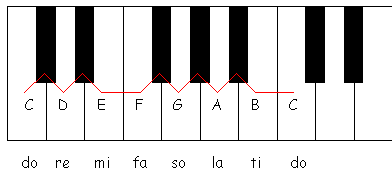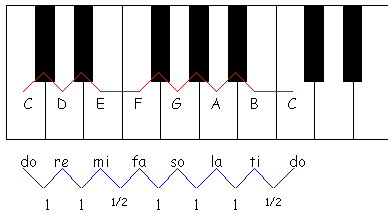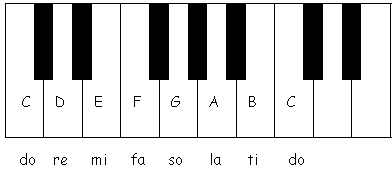Grades 3,4,5 – 45 minute lesson
When students understood the concepts of whole and half steps, so many things had greater meaning; scale patterns, intervals, key signatures, major, minor, etc. This year it all came together and Bach* made it possible!
A little bit of the flow:
Bach is known as the “Father of Modern Western Music.” This includes, rock, jazz, country, classical, rap, and all the rest. Sounds strange I know, but, he perfected something that all western music uses today. Here is what he perfected.
The following diagram is on the board

We already know the scale syllables, let’s put them under the note letter names:
The red lines in the diagram below represent steps.
There are 12 1/2 steps from do to do. Count them as I draw the lines:

These 12 1/2 steps were not invented by Bach. Bach was the first composer to use the equal distance between these steps, in all the scales of keyboard instruments played during his time. This equal distance is measured by sound vibrations.
This shows that the sound vibrations of each step increases by 10. Knowing that the next 1/2 step will be 10 vibrations faster than the last allows us to know exactly what pitch will be sounded. Before Bach used these equal steps, instruments were tuned differently. Today we still use these equal steps. Rap, classical, rock, jazz, blues, and country music all use these steps. This is why we can say Bach is the “father of modern western music.” Bach helped put us all “in tune.”
Let’s listen to these 12 1/2 steps. Hear how they are all equal? I will play them again, but, somewhere I will play a whole step, because two 1/2 steps make a whole step, and you will hear the difference. See you can hear when we skip a step.
Now let’s go back and look at the scale syllables again.

If each red line is a 1/2 step, then the distance from do to re is two 1/2 steps, or 1 whole step. What is the distance from re to mi? The distance from mi to fa is one 1/2 step. Let’s finish the rest, call out whole or 1/2 step as I point to the next syllable. So, the scale is really a pattern of whole and 1/2 steps. We call it a MAJOR SCALE because of this pattern of steps: 1 – 1 – 1/2 – 1 – 1 – 1 – 1/2. As long as you follow this pattern of whole and 1/2 steps, you can start from any key on the piano and play a MAJOR SCALE. The easiest MAJOR SCALE to play is from C to C because you always play the next “white” key. There are no sharps or flats in the C MAJOR SCALE. If we start on “G” it will be called the G MAJOR SCALE. Let’s start on “G” and see what keys we play to make the pattern correct. Now we have a black key, in this case an “F#” has to be played to make the last whole step complete, and the 1/2 step is from F# to G.
What would the scale be called if we started on “F”? “B”? “D#”? “Bb”? Right, they take the name of the first letter name.
You can sing a 1/2 step. You already know how to sing the scale. When you sing from mi to fa, or from ti to do, you are singing a 1/2 step. Let’s do it together. Sing do-re-mi. Now from mi to fa. Hear how close fa was to mi? That is the step. Let’s go on up to ti – now from ti to do. There is the 1/2 step again.
When you go to centers today, I want you to play the C MAJOR SCALE. After you have played it completely, raise your hand and I will come over to see you play. If you are really good, you can call out the whole and 1/2 step pattern as you play. Certificates will be given to all who can play the C major scale
This lesson was expanded to include the minor scale pattern, starting on la or 6 of the major scale, and how major starts on Do, while minor starts on La of the major scale.
Before the next lesson, which was reading a new song using the formats, we reviewed counting the 1/2 steps and showing the whole and 1/2 steps of the major scale.
With the understanding of these 12 equal steps, the concepts of intervals and singing correct pitches will all have greater meaning and become mastered sooner.
It’s so exciting!
* While Bach did was not the first to invent equal temperament. He was instrumental in making it become widley accepted.

